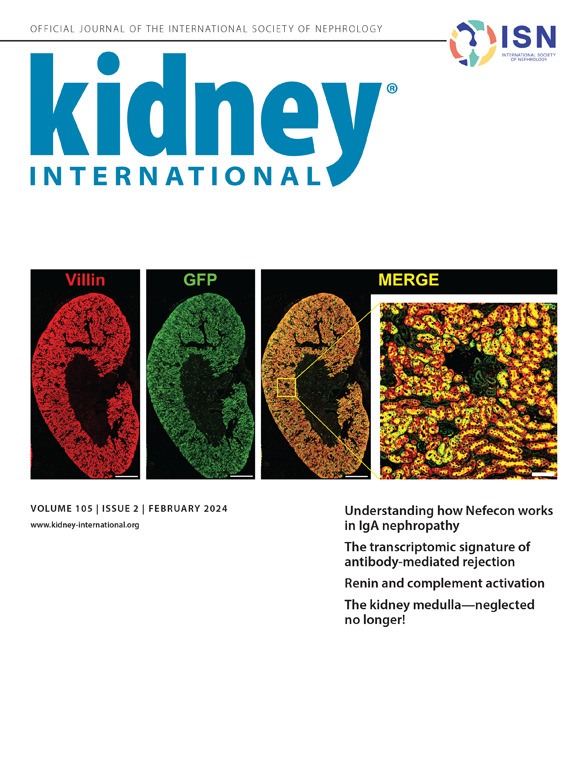The Mayo MGRS Prediction Tool calculates the risk of finding monoclonal gammopathy of renal significance in a kidney biopsy in patients with monoclonal gammopathy
IF 14.8
1区 医学
Q1 UROLOGY & NEPHROLOGY
引用次数: 0
Abstract
Introduction
Monoclonal gammopathy of renal significance (MGRS) is increasingly recognized as an important cause of kidney failure. A kidney biopsy remains an important diagnostic measure. However, a kidney biopsy is not without risks. Here, we devised the Mayo MGRS Prediction Tool to assess the probability of finding MGRS in patients with chronic kidney disease with monoclonal gammopathy (MG).
Methods
We included patients from 2013 to October 2023 who underwent a kidney biopsy at the Mayo Clinic excluding those whose hematological condition required specific treatment due to tumor burden such as multiple myeloma.
Results
Of 280 patients, 92 (32.9%) had MGRS lesions with amyloid light chain or primary amyloidosis being the most common lesion in 38 patients (41.3%). We performed multivariable logistic regression with forward variable selection to fit the model. The final model included eight predictors: diabetes, affected/unaffected free light chain ratio, urinary protein (g/24 hours), positive urine protein electrophoresis or immunofixation electrophoresis, serum creatinine, C3 level (mg/dL), hematuria, and systolic blood pressure. The calculated and optimism-corrected area under the curve was 0.896 and 0.836, respectively. The decision curve analysis showed that the model provided net benefit across all thresholds. A threshold probability of 0.10 was 98.9% sensitive and 50.5% specific, and a threshold probability of 0.25 was 88.0% sensitive and 70.2% specific. The model was validated using an external cohort of 109 patients from the University of Minnesota with good performance.
Conclusions
Our Mayo MGRS Prediction Tool is useful in assisting clinicians in predicting the probability of finding an MGRS lesion in a kidney biopsy.

Mayo MGRS预测工具计算单克隆γ病患者在肾活检中发现有肾脏意义的单克隆γ病的风险。
肾重要性单克隆γ病(MGRS)越来越被认为是肾衰竭的一个重要原因。肾活检仍然是一种重要的诊断方法。然而,肾活检并非没有风险。在这里,我们设计了Mayo MGRS预测工具来评估慢性肾脏疾病合并单克隆伽玛病(MG)患者发现MGRS的概率。方法:我们纳入了2013年至2023年10月在梅奥诊所(Mayo Clinic)接受肾活检的患者,排除了因肿瘤负担(如多发性骨髓瘤)而血液学状况需要特殊治疗的患者。结果280例患者中,92例(32.9%)有MGRS病变,其中38例(41.3%)以淀粉样蛋白轻链或原发性淀粉样变性最为常见。我们使用正向变量选择的多变量逻辑回归来拟合模型。最终模型包括8个预测指标:糖尿病、受影响/未受影响的游离轻链比、尿蛋白(g/24小时)、尿蛋白电泳或免疫固定电泳阳性、血清肌酐、C3水平(mg/dL)、血尿和收缩压。曲线下计算面积为0.896,乐观修正面积为0.836。决策曲线分析表明,该模型在所有阈值上都提供了净效益。阈值概率为0.10,敏感98.9%,特异50.5%;阈值概率为0.25,敏感88.0%,特异70.2%。该模型通过来自明尼苏达大学的109名患者的外部队列进行验证,效果良好。结论Mayo MGRS预测工具有助于临床医生预测肾活检中发现MGRS病变的概率。
本文章由计算机程序翻译,如有差异,请以英文原文为准。
求助全文
约1分钟内获得全文
求助全文
来源期刊

Kidney international
医学-泌尿学与肾脏学
CiteScore
23.30
自引率
3.10%
发文量
490
审稿时长
3-6 weeks
期刊介绍:
Kidney International (KI), the official journal of the International Society of Nephrology, is led by Dr. Pierre Ronco (Paris, France) and stands as one of nephrology's most cited and esteemed publications worldwide.
KI provides exceptional benefits for both readers and authors, featuring highly cited original articles, focused reviews, cutting-edge imaging techniques, and lively discussions on controversial topics.
The journal is dedicated to kidney research, serving researchers, clinical investigators, and practicing nephrologists.
 求助内容:
求助内容: 应助结果提醒方式:
应助结果提醒方式:


